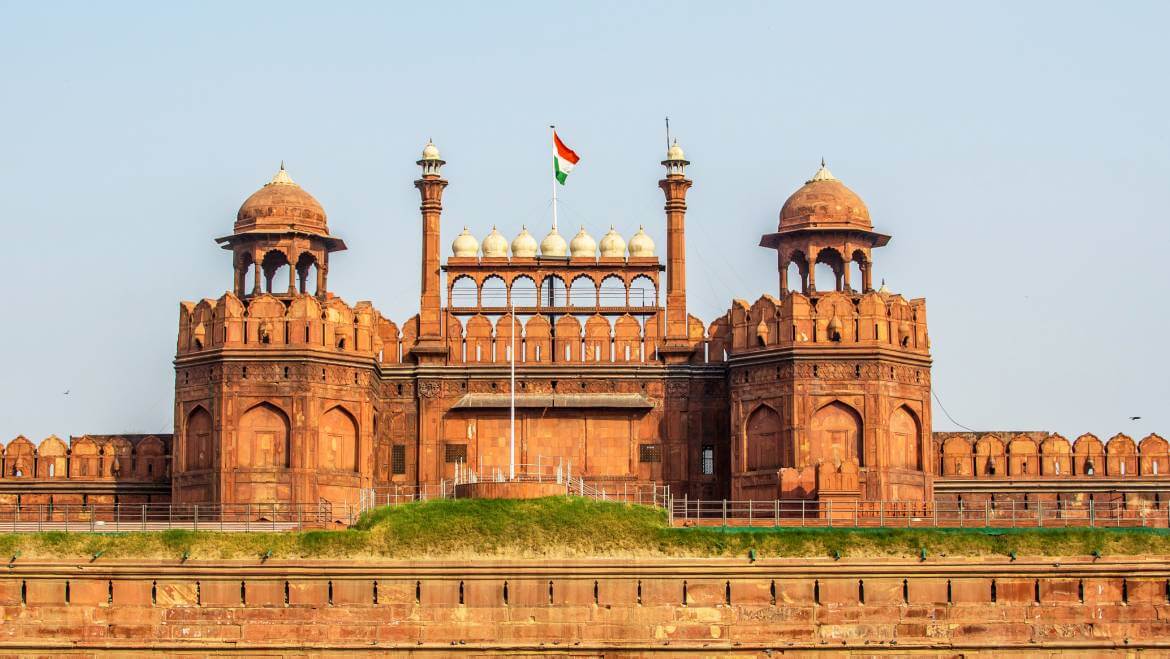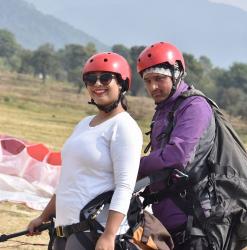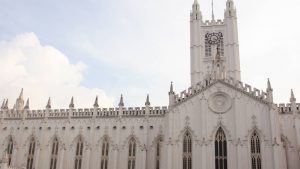“Learn about India’s rich culture by exploring its top 30 heritage destinations situated in various cities of the country. These attractions will take you back in time to the world of ancients and make you aware about the richness of culture, wealth, tradition and skill that existed several years ago.”
With a history dating back to nearly 5000 years or even more, the present-day India introduces itself as a tourist destination, perfect for learning about various civilizations. Further, several spiritual leaders and founders of many popular religions of the contemporary times dwelled in the country’s various regions. India’s authentic wealthy trove of culture, crafts, mysticism, art, philosophy, tradition, music and architecture has been luring travellers, scholars and history buffs across the globe from long past.
Relish the experience of exploring the country’s ancient relics and architectural ruins rising over teeming cities, streets and roads. This is a land of a huge contrast where tradition and modernity mingle to offer mind-boggling memories that will remain in the mind for a very long time.
Don’t you wish to seek genuine insights into India’s rich religious heritage? Visit these below mentioned attractions to satiate your desire-
- Mahabodhi Temple, Bodh Gaya, Bihar
- Humayun’s Tomb, Delhi
- Red Fort, New Delhi
- Jama Masjid, Delhi
- Taj Mahal, Agra
- Qutub Minar, Delhi
- Group of Monuments, Hampi Karnataka
- Group of Monuments at Pattadakal, Karnataka
- Buddhist Monuments at Sanchi, Madhya Pradesh
- Khajuraho Group of Monuments, Madhya Pradesh
- Ajanta and Ellora Caves, Maharashtra
- Jantar Mantar, Jaipur Rajasthan
- Mahabalipuram, Tamil Nadu
- Fatehpur Sikri, Uttar Pradesh
- Sun Temple, Konark Odisha
- Kumbhalgarh Fort, Udaipur Rajasthan
- Chittorgarh Fort, Udaipur Rajasthan
- Jaisalmer Fort, Rajasthan
- Amer Fort, Jaipur Rajasthan
- Rani Ki Vav Patan Gujarat
- Nalanda University Bihar
- Champaner Pavagadh Archaeological Park
- Gagron Fort, Rajasthan
- Ranthambore Fort, Rajasthan
- Western Ghats
- Kakatiya Rudreshwara Ramappa Temple, Telangana
- Madavoorpara Rock Cut Temple, Kerala
- Akhnoor Fort, Jammu and Kashmir
- Khetri Mahal, Rajasthan
Also Check Out: All Inclusive Popular Heritage Tour Packages
Mahabodhi Temple, Bodh Gaya, Bihar
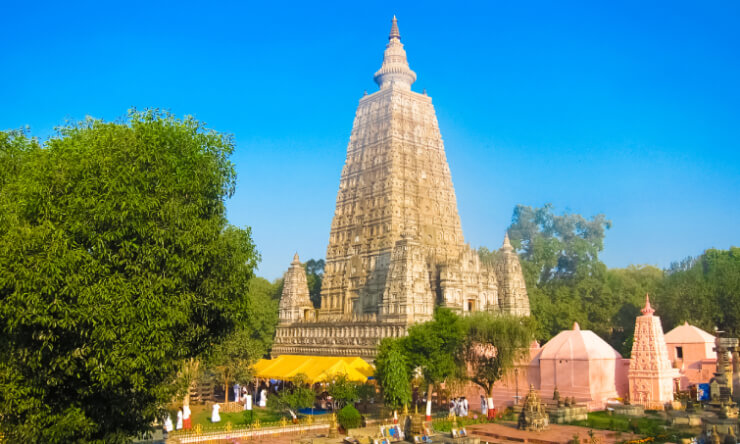
A prince named Siddhartha Gautam (Lord Budhha) came here to attain Nirvana in the sixth Century B.C.; Mahabodhi temple is the holiest destination of Buddhists. Not only Buddhists, but millions of Hindus from around the globe visit this temple to pay their homage to Lord Budhha. This temple of historical and cultural importance has been honouring the Gaya district of Bihar since 260 B.C.
The sacred Bodhi tree dwelling in the complex of the temple is believed to be a spot where Buddha used to meditate for transcending the cycle of reincarnation. Thus, it is looked at as the holiest spot in the complex. Buddha’s place of meditation, next to the Bodhi Tree, is acquired by a Buddha statue on polished sandstone, which was installed by Emperor Asoka in the third Century B.C.
This heritage site of India has several places where Lord Buddha meditated after attaining complete bliss. According to a temple website, there is a site in the premises where he stood meditating for a week without moving his eyes.
Mahabodhi Temple is a UNESCO’s World Heritage Site.
General Information
- Entry Fee: No charges
- Timings: 5 a.m. until 9 p.m.
- Camera: 20 INR, and 300 INR for video cameras.
The meditation park is open from sunrise until sunset. The entry fee is 20 INR for visitors and 25 INR for the ones who meditate.
Other Interesting Blog to Read
Humayun’s Tomb, Delhi
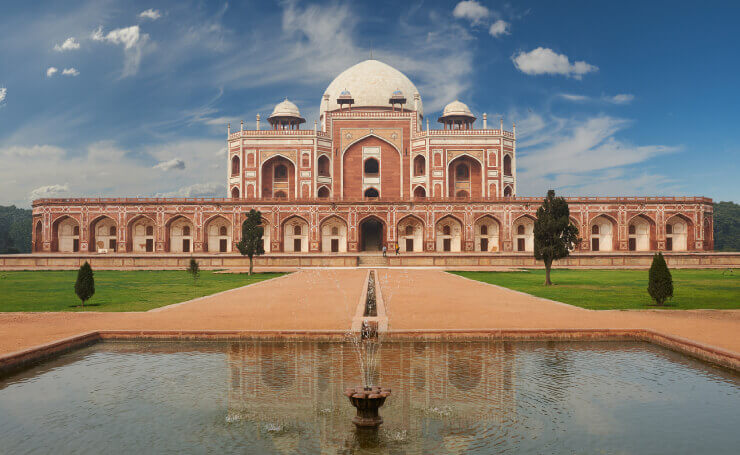
Individuals longing for quintessential Mughal architecture should head to Delhi’s Humayun Tomb – one of the most popular heritage destinations of India. Humayun was the son of the first Mughal Emperor of India – Babur. Haji Begum, Humayun’s Persian wife, looked after the construction, which began in 1569 (fourteen years after Humayun’s death).
The tomb stands in the centre of a square garden, and causeways (charbagh) separate this Mughal Tomb into four main gardens. Further, there are water-channels in the centre. You can enter this enclosure through two majestic double-storied gateways situated on the west and south.
Constructed with red sandstone, this tomb looks beautiful and the first Charbagh gardens in India were built in front of the tomb. Later, on the basis of Humayun’s tomb, large-scale gardens were built in front of many Mughal buildings. It is spread over an area of 30 acres, water fountains and canals enhance the beauty of the mausoleum. Its unique beauty can be said to be inspired by several major architectural innovations, which led to the construction of the Taj Mahal.
Red Fort, New Delhi

When it comes to magnificent heritage holidays in India, exploring the glorious complex of the Red Fort is a must. Constructed as the palace fort of Shahjahanabad, which is the new capital of Shah Jahan – the fifth Mughal Emperor of India, Red Fort keeps on narrating the majestic power and pomp of the emperor.
The Red sandstone walls of the huge Red Fort (Lal Qila), which are 33-m high were constructed in 1638 to prevent the entry of the invaders.
The main gate – Lahore Gate – gets immersed in the freedom celebration and draws a major crowd on every Independence Day.
The hemispherical dome of Chatta Chowk, a market (bazaar) attracts tourists with a huge variety of items. Chatta Chowk extends to a large fort compound, consisting of a wonderful collection of huge buildings, including the Drum House, the Pearl Mosque, the Hall of Public Audiences, Royal Baths, Palace of Colour and the white marble Hall of Private Audiences.
An evening sound and light show allows spectators to relive India’s history associated with the fort.
General Information
- Location: Netaji Subhash Marg
- Metro Station: Chandni Chowk
- Open: Tue-Sun; Mondays closed
- Visiting Hours: Sunrise to Sunset
- Entry Fee: 10 INR (Indians), 250 INR (Foreigners)
- Photography: Nil (25 INR for video filming)
- Sound & Light Shows: 6pm onwards in English and Hindi
- Ticket: 80 INR (adults), 30 INR (children)
Also Read: 15 Best Places to Visit in Delhi
Jama Masjid, Delhi
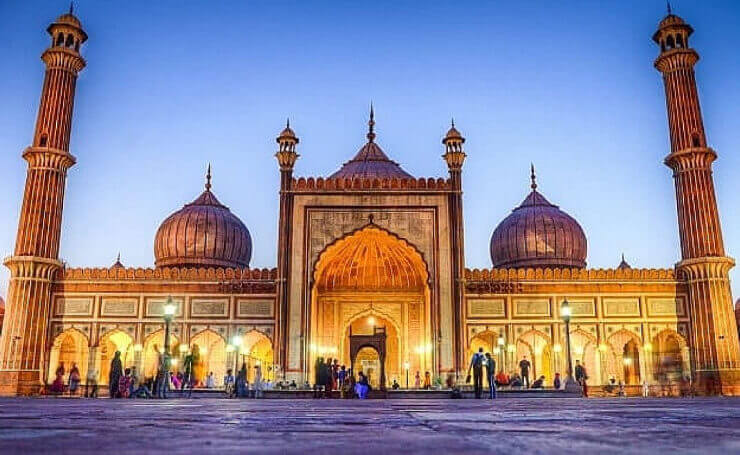
A courtyard with a capacity of 25000 devotees, Jama Masjid located in Old Delhi is the largest in India. It was constructed between 1644 and 1658 and is Shah Jahan’s last architectural opus. This extravagant mosque possesses three great gates, four towers and two 40 m-high minarets.
About 25000 people can come together in its courtyard. It also has three domes on its roof which are surrounded by two minarets. About 899 black borders remain on the floor. The architectural plan of Badshahi Masjid was built by Shah Jahan’s son Aurangzeb in Lahore, Pakistan, which was exactly like Jama Masjid.
With intricate carvings and verses of the holy Koran etched, the walls add to enhance the beauty of Jama Masjid. The cabinet in the north gate has a collection of Muhammad’s souvenirs – the Koran written on deerskin, a red beard-hair of the prophet, his sandals and his footprints, which are embedded in a marble block.
General Information
- Location: Off Netaji Subhash Marg, west of Red Fort
- Metro Station: Chawri Bazaar
- Open: All days of the week
- Visiting Hours: 7am to Noon, 1.30pm to 6.30pm. Tourists not allowed during prayer hours
- Entry Fee: Free
- Photography: 200 INR
Other Interesting Blogs to Read
Taj Mahal, Agra
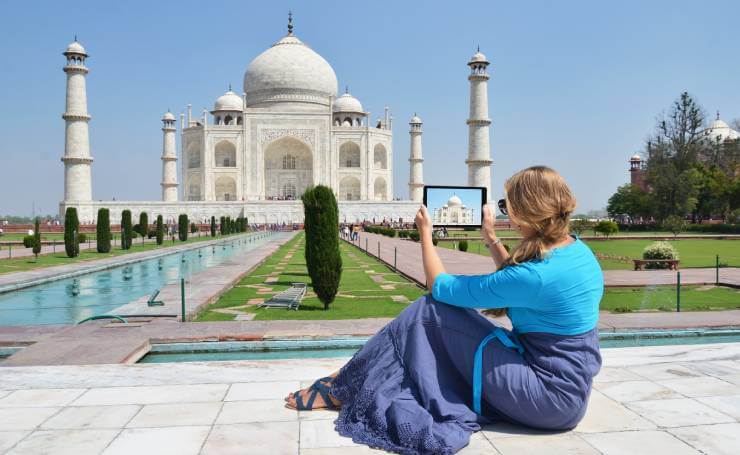
Famously said by many – ‘Elegy in Marble’, Taj Mahal or the Crown Palace is the grave of Shah Jahan’s beloved Queen, Mumtaz Mahal. It is one of the most visited heritage tourist attractions in India.
The beauty of this Palace exceeds all other material beauties, which is heightened with the Jamuna River, which flows near it.
To meet the expectation of the emperor, 22 years (completed around 1953) and around 20000 workers travelled to construct this magnificent construction in Agra, Uttar Pradesh, standing on an elevated platform, which forms an unequal octagon. Taj Mahal intricate detailing engraved on the walls lets India’s travel and tourism shine worldwide.
What interests most historians and archaeologists are the complex geometrical patterns incorporated into the designing of the colossal Palace. The main central dome is large and four more domes surround the main one. There are four tall minarets that have taken up the four corners.
General Information
- Location: Located in Agra, U.P. Approx 200 kilometres (125 miles) from Delhi. It’s a famous city of India’s popular Golden Triangle tour.
- Entry Fee: 750 INR (Foreigners), 510 INR (Citizens of SAARC and BIMSTEC Countries), 20 INR (Indian), free entry for children below 15 years of age.
Other Interesting Blogs to Read
Qutub Minar, Delhi
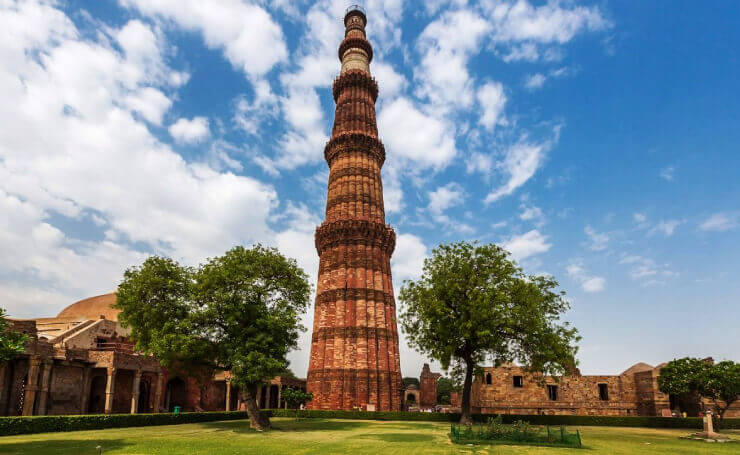
Built in 1192 to depict the beginning of Islamic rule in India – Qutub Minar stands 73m high, is a tower of victory as the building’s construction was commenced by Qutub-ud-din-Aibak right after he declared his victory over the last Hindu kingdom in Delhi.
The Qutub tower is made up of distinct storeys, and each has a projecting balcony. The diameter of the storeys decreases gradually when measured from top to bottom – 15 m diameter at the base to just 2.5 m at the top. Red sandstone heightens the beauty of the three stores, while the fourth and fifth storeys are beautified with marble and sandstone. The ground floor of the tower is a Quwwat-ul-Islam Mosque, which is considered as the first mosque to be constructed in India.
An interesting fact to know – The inscribed letters over the eastern gate explain that the Qutub Minar was constructed with the material incurred after destroying ’27 Hindu temples’.
Qutub Minar in Delhi is one of the renowned heritage tourist places of India. It is visited by several tourists every year.
General Information
- Location: Mehrauli
- Nearest Metro Station: Qutub Minar
- Open: All days
- Entry Fee: 10 INR (Indians), 250 INR (foreigners)
- Days Closed: None
Other Interesting Blog to Read
Group of Monuments, Hampi Karnataka
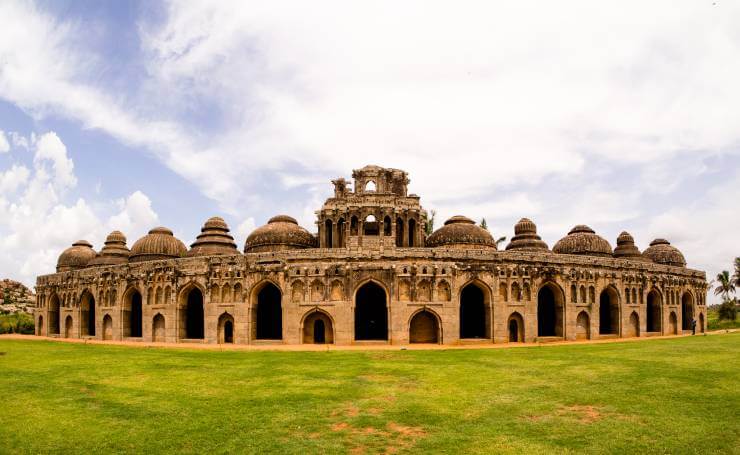
Satiate your desire of exploring ancient relics by exploring the pompous group of monuments at Hampi, Karnataka. There are several Dravidian temples and palaces constructed during the 14th and 16th centuries and are of great vitality for both historians as well as architects. This spot was declared as a World Heritage Site in 1986.
Heritage holidays at Hampi are heavenly because tourists get to witness larger than life size statues of God, positioned every quarter of a mile. Other wonderful spots of the place are Virupaksha Temple, Hazara Rama Temple, Vithala Temple, Queen’s Bath, Singaradu Hebbagilu, Ugra Narasimha, Lotus Mahal, and the ruins of Achyutaraya Temple.
General Information
- Visiting Hours: Open from sunrise to sunset
- Entry Fee: 10 INR for Citizens of India and visitors of SAARC and BIMSTEC Countries, 250 INR for others and no entry fee for children up to 15 years.
Other Interesting Blog to Read
Group of Monuments at Pattadakal, Karnataka
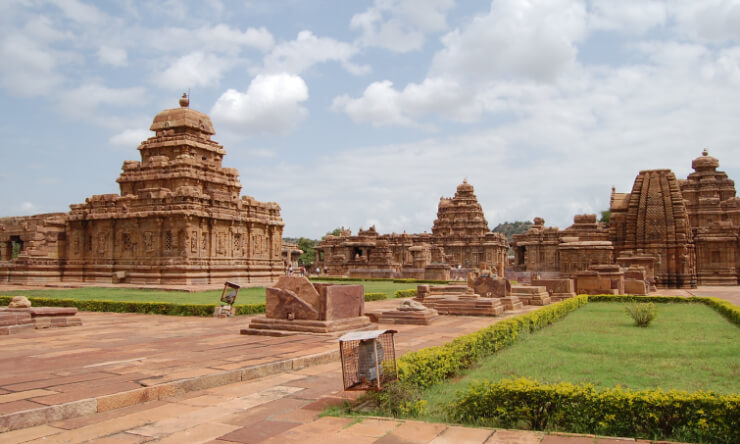
If you wish to relive the time in which land of India got wealthy with some beautiful architectural marvels that were constructed during the Chalukya dynasty (Indian royal dynasty, ruled big areas of southern and central India between the 6th and the 12th centuries), then head to Pattadakal, a small town, famous for its ancient temples. Pattadakal is located in Karnataka, was once the second largest city of the Chalukyas. It was a place for Chalukyas Coronation.
The temples in Pattadakal, a World Heritage Site, are constructed in Rekha, Nagara, Prasada and the Dravida Vimana styles. The oldest temple is Sangamesvara, constructed by Vijayaditya Satyasraya (AD 697-733). The other famous temples are the Kadasiddhesvara, Jambu Lingeshwara both belonging to 7th century A.D. while Galaganatha temple is a century later in the style of Rekha, Nagara, and Prasada. The Kasivisvesvara temple was the last to construct early Chalukyan style. The Mallikarjuna temple by Rani Trilokyamahadevi was built basically to cherish the victory over the Pallavas by Vikramaditya II. She also supported the construction of Virupaksha temple inspired by the architecture of the Kailasanatha temple at Kanchipuram.
However, the last temple built at Pattadakal was during the reign of Rashtrakuta ruler Krishna II (9th century A.D.). The temple is locally renowned as Jaina Narayana.
General Information
- Visiting Hours: Open from sunrise to sunset
- Entry Fee: INR 10 for citizens of India and visitors of SAARC and BIMSTEC Countries (Bangladesh, Nepal, Bhutan, Sri Lanka, Thailand and Myanmar), INR 250 (Others) and children up to 15 years can enter without any fee.
Other Interesting Blog to Read
Buddhist Monuments at Sanchi, Madhya Pradesh
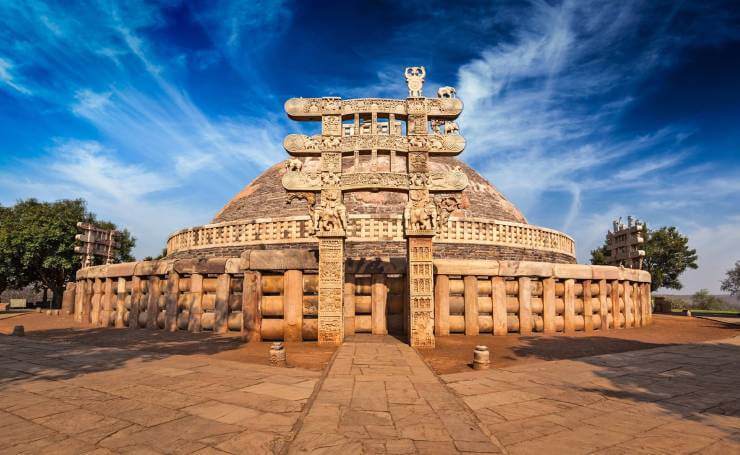
Travel 46 km northeast of Bhopal to get refined in Sanchi, where brilliant Buddhist monuments are honouring the big Indian state – Madhya Pradesh. On your heritage holidays in India explore this oldest Buddhist sanctuary, which was a major Buddhist hub in 12th A.D. This holy centre comprises several complex structures of the renowned Buddhist legends. Besides, there are also several monolithic pillars, temples, monasteries, palaces and most of them are built in1st and 2nd centuries A.D. In this plethora of monuments, a world-renowned monument that gets highlighted because of its beautiful and massive dome is the great Stupa. It was constructed by Emperor Ashoka.
In this plethora of monuments, a world-renowned monument that gets highlighted because of its beautiful and massive dome is the great Stupa. It was constructed by Emperor Ashoka.
General Information
- Visiting Hours: Sunrise to Sunset
- Entry Fee: INR 10 for citizens of India, US $ 5 for foreigners and children up to 15 years can enter without any fee.
Other Interesting Blog to Read
Khajuraho Group of Monuments, Madhya Pradesh
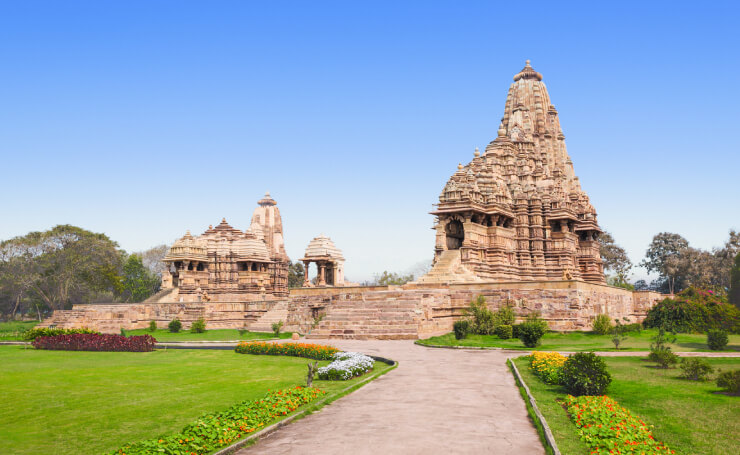
Kamasutra cravings embracing the Khajuraho’s three groups of temples are among the amazing temple art in the world. Situated in the state of Madhya Pradesh in India and about 1000AD years old; the temples of Khajuraho were constructed during the Chandella Dynasty. In these temples, you will also get to appreciate the marvels of Jain and Brahman monuments. It is the sheer beauty and architecture of these monuments, which made them UNESCO world heritage sites.
Out of 85, only 22 managed to survive. In most of the monuments, sandstone of various colours is the main element of construction. All the monuments have an entrance, hall, vestibule and a sanctum, and fresh air and proper light can enter from huge windows of the temples.
There are western region, eastern region and southern region of Khajuraho. In the western part, you will find Kandariya Mahadeo, Chaunsat Yogini, Lakshmana Temple, Vishwanath Temple, Chitragupta Temple and Matangeshwar Temple. On the eastern part of Khajuraho, marvellous temples that can be spotted are Adinatha Temple, Brahma temple, Vamana temple, Ghantai Temple, Parsavanatha Temple and Javari temple. In the southern part, explore the Duladeo Temple, and Chaturbhuj Temple.
The Khajuraho Dance Festival is organised every year in the first week of February (1st to 7th). Through this festival, the visitors can relish an opportunity to get introduced with various classical Indian dances.
General Information
- Visiting Hours: Sunrise to Sunset
- Entry Fee: 10 INR for Indians, US $ 5 for foreigners and children up to 15 years can enter without any fee.
Other Interesting Blog to Read
Ajanta and Ellora Caves, Maharashtra
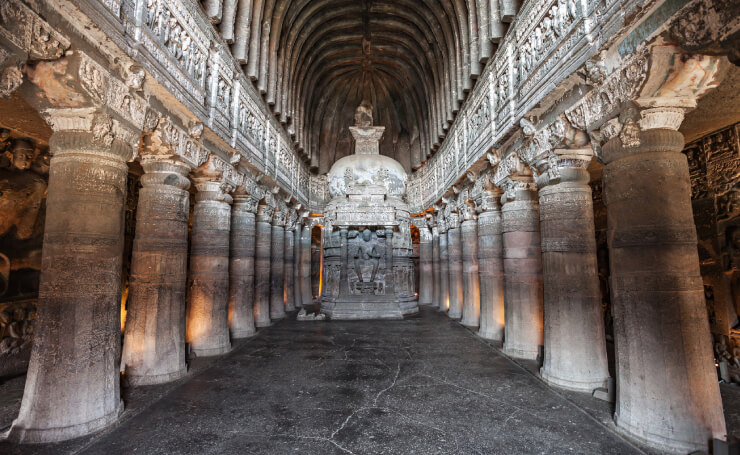
To explore an amazing architectural site, you have to go deep into Maharashtra’s Aurangabad to get introduced with the mesmerising Ajanta and Ellora Caves, snugged in the Sahyadri Hills. The cave shrines date back to 2nd century BC and were created by then skilled artisans with their hands. Being one of the popular heritage places around the world, the caves are accepted as an excellent example of ancient Indian architecture.
The 34 caves at Ellora were chipped during the 350 AD to 700 AD period to showcase the three religions – Hinduism, Buddhism and Jainism. While the 29 caves at Ajanta were carved during a period from 200 BC to 650 AD describe the story of Buddhism.
In the early 19th century, the long-buried Ajanta Caves were unintentionally discovered by a British Army officer. Since then, these beautiful sculpted caves within the Sahyadri hills above the Waghur river came into sight and have been luring the hearts of tourists.
General Information
- Visiting Hours: From 9 am to 5.30 pm. The caves of Ajanta and Ellora remain closed on Mondays and Tuesdays respectively
- Photography Not allowed inside the caves
Entry Fee
- Ajanta Caves – 10 INR for Indians, US $ 10 for foreigners and children up to 15 years can enter without any fee.
- Ellora Caves – Free entry
Also Read: Heritage Tourism in Maharashtra
Jantar Mantar, Jaipur Rajasthan
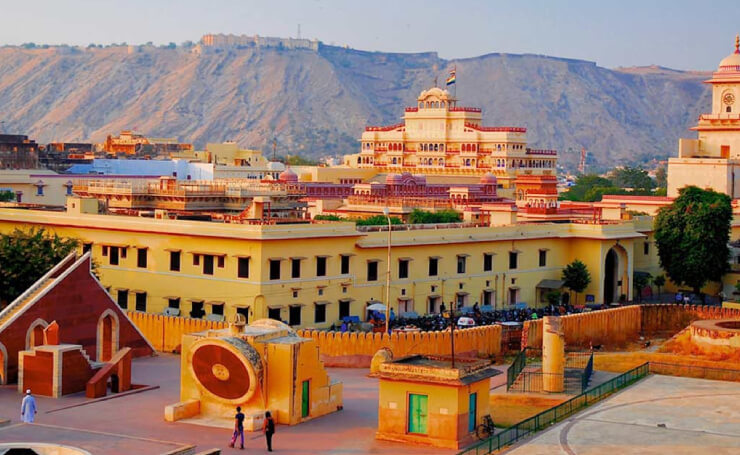
If you wish to witness one of the largest observatories in the world, head to Jaipur. Jantar Mantar, amalgamation of religion, science and art, is a name of the five huge buildings situated in Jaipur, New Delhi, Ujjain, Varanasi and Mathura.
This magnificent structure was constructed in 1720; it was a time when Jaipur was the seat of Maharaja Jai Singh II. Jaipur’s observatory is the biggest of all the five observatories and one can also find a huge sundial here. The Jantar Mantar houses various architectural and astrological instruments that have captured the interests of astronomers, historians and architects around the globe.
The astronomical observatory in Jaipur has fourteen major geometric devices that help in detecting time, identifying the constellations and, even for analysing the orbits around the sun. Renowned buildings inside the Jantar Mantar are the ‘Samrat Yantra’ – world’s largest sundial, the ‘Hindu Chhatri’, the ‘Jai Prakash Yantra’ and several other geometric structures with astronomical devices to examine the ‘universe’.
General Information
- Entry Fee: 40 INR and 15 INR for Indian tourists and Indian students respectively, 200 INR and 100 INR for foreigner tourists and foreigner students respectively and children up to 15 years can enter without any fee.
- Visiting Hours: All days of the week 9:30 AM – 4:30 PM
Also Check Out: Complete Jaipur Tourism Guide
Mahabalipuram, Tamil Nadu
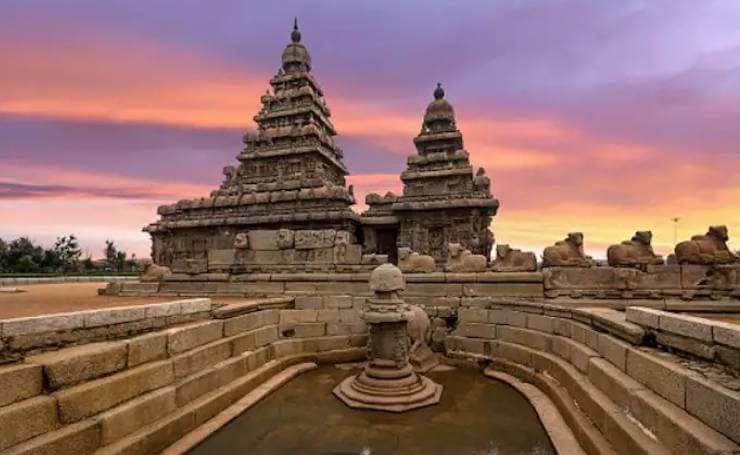
Renowned worldwide for rock carvings and monolithic sculptures; UNESCO World Heritage site at Mahabalipuram was a port of Pallava Empire in 7th century. These monuments will let you have a glimpse of sculptures and carvings showcasing then artisans’ creativity and craftsmanship.
The sculptures were carved from local granite, and the sculptures are categorised into four categories:
– Rock-cut caves
– Monolithic temples or rathas, hewn out of a large boulder
– Bas-reliefs in the open air (Considered as unique artistic achievements)
– Structural temples
Out of many temples, a lavish shore temple bordered by Nandi bulls, facing the sea, offers fascinating sites to the visitors. This temple was established again stone by stone after it was ruined in a cyclone.
The appeal of Mahabalipuram is packed not only in its monumental architecture but the charm of the place can be felt through its glittering sand beach, wonderful handicrafts and stone-carved items that are exhibited for sale near the shore. Various sculptures of Mahabalipuram have inspired those in Cambodia, Annam and Java.
General Information
- Visiting Hours: Open from 6 A.M. to 6 P.M.
- Entrance Fee: INR 10 for citizens of India and visitors of SAARC (Bangladesh, Nepal, Bhutan, Sri Lanka, Pakistan, Maldives and Afghanistan) and BIMSTEC Countries (Bangladesh, Nepal, Bhutan, Sri Lanka, Thailand and Myanmar), US $ 5 for foreigners and children up to 15 years can enter without any fee.
Other Interesting Blog to Read
Fatehpur Sikri, Uttar Pradesh
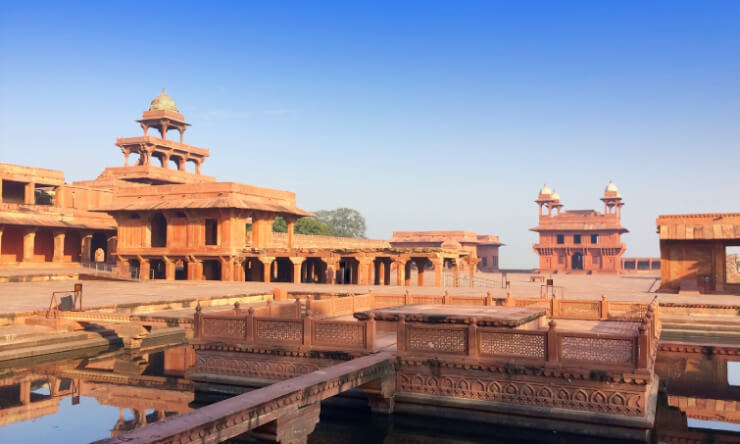
Fatehpur Sikri adds a scintillating feather on the hat of India’s Travel and Tourism industry. This Mughal architecture lures thousands of tourists every year in Uttar Pradesh. Situated 26 kms away from the main city of Agra; this monument was constructed by Akbar to pay homage to a great Sufi saint.
The architecture of Fatehpur Sikri has true Indian character. The walls of monument possess versatile Indo-Muslim composite style designs, which are a fusion of composite cultures.
Babur, the founder of the Mughal Empire, defeated Rana Sanga at a place called Sikri and took possession of this place. The city of Fatehpur Sikri holds its own special place since the Mughal period because it is believed that Akbar had no successor, so Akbar was going to the shrine of Khwaja Moinuddin Chishti in Ajmer with the wish of having children with his Begum Heer Kunwari Bai.
On his way to Ajmer, Akbar met Sufi saint Sheikh Salim Chishti at a place called Sikri. Sheikh Salim Chishti asked Akbar to decide for his stay and prayed for the fulfilment of Akbar’s wish. So, Akbar decided for their stay in Sikri itself. After some time, Akbar got a son from Heer Kunwari’s womb.
Pleased with this, Akbar planned for the establishment of a new city, Fatehpur Sikri. It took Akbar about 15 years to prepare this plan. After which in 1559 AD a new city Fatehpur Sikri was established by the Mughal ruler Akbar. According to him, Fatehpur Sikri is called the city of Akbar’s dreams due to the establishment of this city.
General Information
- Visiting Hours: Sunrise to Sunset
- Entry Fee: 10 INR for citizens of India and visitors of SAARC (Bangladesh, Nepal, Bhutan, Sri Lanka, Pakistan, Maldives and Afghanistan) and BIMSTEC Countries (Bangladesh, Nepal, Bhutan, Sri Lanka, Thailand and Myanmar), US $ 5 for foreigners and children up to 15 years can enter without any fee.
Also Check Out: Popular Tourist Attractions in Uttar Pradesh
Sun Temple, Konark Odisha
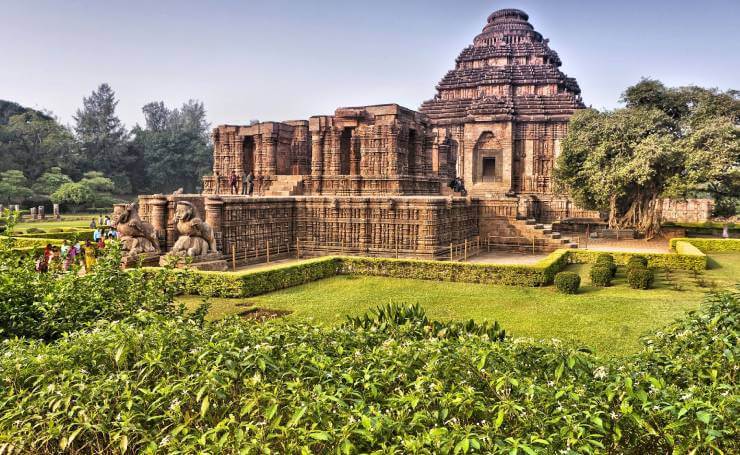
Situated on the bank of the Bay of Bengal, embracing the rays of the glistening sun, the temple at Konark represents sun god Surya’s chariot. Chariot’s 24 wheels are graced with beautiful designs and it is headed by six horses. Constructed in the 13th century, the temple is one of India’s most famous Brahman sanctuaries and portrays the grace, the joy and the rhythm of Kalinga life.
Explore this beautiful Indian heritage spot in Orissa to get amused with the decorations such as small patterns in bas-relief performed with great precision and also huge free-standing sculptures of animals and humans.
General Information
- Visiting Hours: Sunrise to Sunset
- Entry Fee: 10 INR for citizens of India and visitors of SAARC (Bangladesh, Nepal, Bhutan, Sri Lanka, Pakistan, Maldives and Afghanistan) and BIMSTEC Countries (Bangladesh, Nepal, Bhutan, Sri Lanka, Thailand and Myanmar), US $ 5 for foreigners and children up to 15 years can enter without any fee.
Other Interesting Blog to Read
Kumbhalgarh Fort, Rajasthan
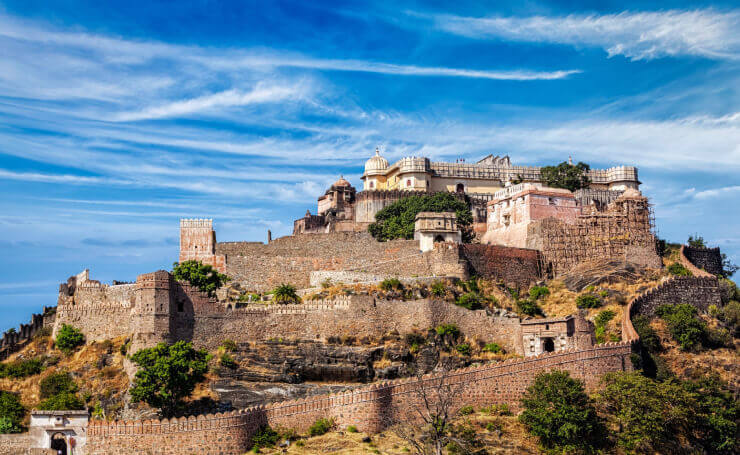
Drive 84 kms north of Udaipur in the wilderness to explore the splendid Kumbhalgarh Fort, cradling in the Aravalli Ranges of the fort. This fort was built in 15th century AD by Rana Kumbha, and the fort temporarily dwelled by Mewa rulers in the times of strife. It is of great significance for the people as it is the birthplace of – Maharana Pratap, Mewar’s legendary king.
This fort has also been included in the UNESCO World Heritage Site; this fort is also the second largest fort of Rajasthan. Mighty kings like Maharana Kumbha, Maharana Pratap, Maharana Udai Singh, Maharana Sanga, Kunwar Prithviraj ruled over this magnificent fort.
From the fort one can have a superb view of the surroundings. The fort’s huge wall extends some 36 kms with a width enough to tackle any attack. In the 19th century, the fort was renovated by Maharana Fateh Singh. The fort’s complex has ruins that hide great history.
General Information
- Visiting Hours: 8:00 AM – 6:00 PM (All days of the week)
- Entry Fee: 10 INR for Indians, 100 INR for Foreigners
Also Read: Heritage Tourism in Rajasthan
Chittorgarh Fort, Rajasthan
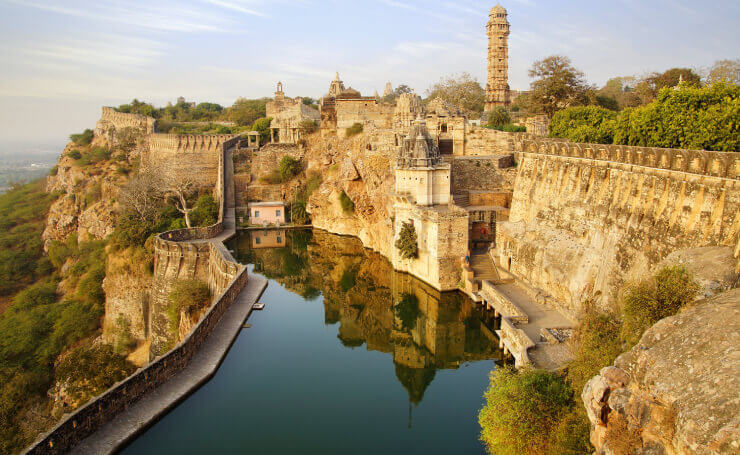
Heritage holidays in India can get magnificent when you explore the largest fort of India – the Chittorgarh Fort – a place holding great importance in history; wonderful palaces and destroyed walls will explain to you about the bravery of numerous warriors. Spreading on an area of 700 acres and extends up to 3 kilometres in length on a high hill near the Gambhiri River in Chittorgarh; this massive fort has 65 mediaeval structures, 4 palace complexes, 19 temples, 4 war memorials or the stambhs and 22 water bodies.
This first hill fort of Rajasthan is believed to be constructed by Mauryan rulers and Sisodiya clan of Rajputs during the 7th century AD.
This fort is very popular for the war of 1303 AD, Khilji attacked this fort. At that time, Raja Rawal Ratan Singh was ruling here.
There were 7 such doors in this fort which were not easy to penetrate but Khilji had spread his army around this kingdom. Due to which there was a shortage of food inside the fort and after about 7 months there was a war.
Raja Rawal Ratan Singh and his brave companion Gaura-Badal were martyred in this war. Khilji then took over this fort. But after sometime this fort was occupied by the Rajputs.
Chittorgarh Fort invites numerous travellers every year who wish to get mesmerised by majestic history that let them spend some time in seclusion to contemplate over the heroism of Mewar rulers.
General Information
- Entry fee: 5 INR for citizens of India, 100 INR for Foreigners
- Camera: 25 INR (Photography & Videography)
Other Interesting Blog to Read
Jaisalmer Fort, Rajasthan
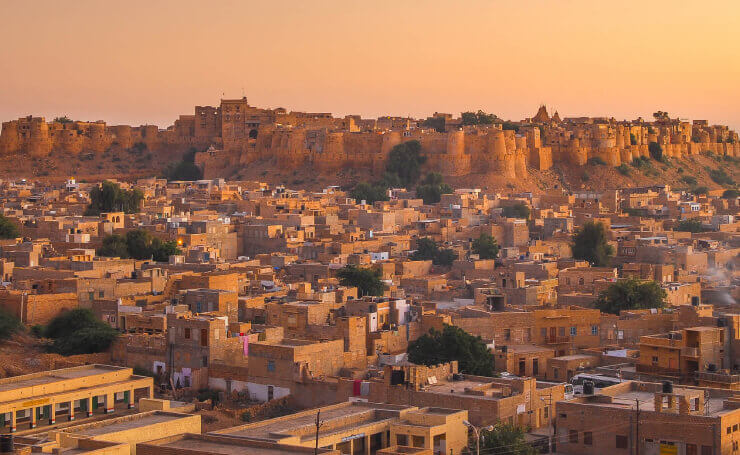
Visit here to retain it in your mind for a long – Jaisalmer Fort is one of the many heritage tourist places that will easily capture your attention. Explore this fort to get acquainted with different aspects of its own gracious heritage – Epitome of Indian artwork and military magnificence. Wonderful foundation of this fort is set in the middle of the sandy terrain of the Great Thar Desert.
Made of yellow sandstones; the fort was built by Raja (King) Jaiswal on the top of Trikuta Hill in the 12th century. The 250 feet tall fort surrounded by fortified walls of 30 feet and 99 bastions for guns depict the planning of the king against the attack.
You will surely relish the fusion of Rajput and Islamic architectural styles that are quite visible in this fort. Do not miss to appreciate the beauty of Ganesh Pol, Akshya Pol, Suraj Pol and Hawa Pol.
General Information
- Visiting Hours: Early morning till 5 P.M.
- Entry Fee: 30 INR for citizens of India, 50 INR for foreign tourists
- Camera: 70 INR per still camera and 150 INR camcorder
Also Check Out: Complete Jaisalmer Tourism Guide
Amer Fort, Jaipur Rajasthan
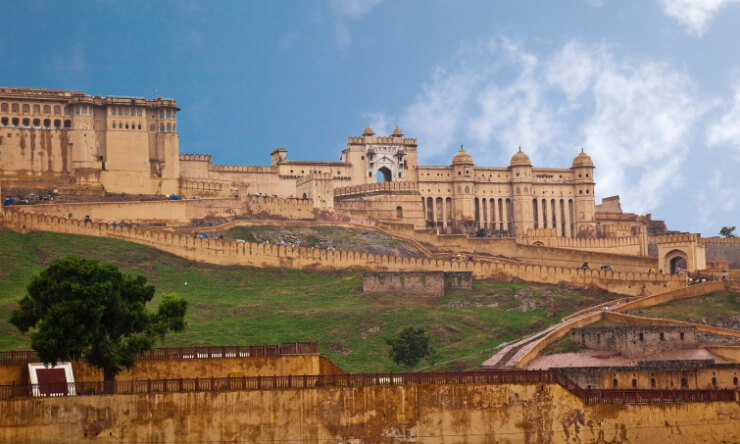
Gracing the land of Amber with its magnificent presence – Amer Fort was constructed in 1592 by Raja Man Singh. The beauty of the red sandstone and marble building gets enhanced with the presence of Moatha Lake. The architecture of building showcases both Hindu as well as Muslim architectural designs.
The fort comprises Shila Devi Temple and Ganesh Pol – a gate leading to the private palaces. There are several pavilions, halls and other popular attractions to entertain your senses.
General Information
- Visiting Hours: 8 am to – 5.30
- Entry Fee: 25 INR for citizens of India and 200 INR for foreigners
Other Interesting Blog to Read
Rani Ki Vav Patan Gujarat
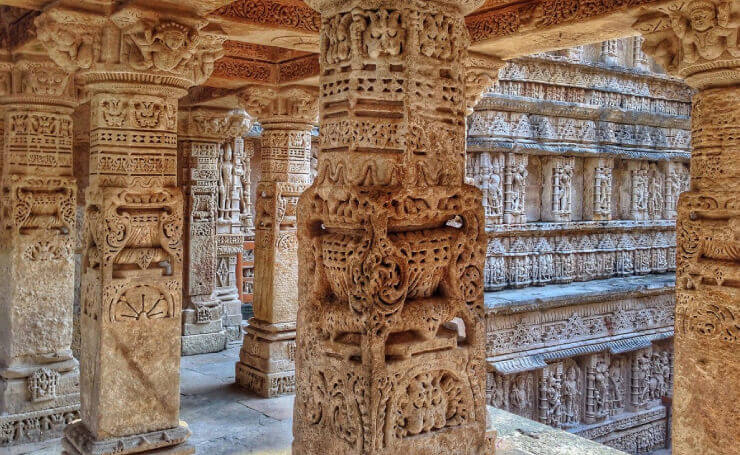
UNESCO declared Rani ki Vav as queen of all stepwells in India. This maru-gurjara architectural style stepwell is one of the most popular heritage tourist destinations in India. Built in a complex technique it overshadows the beauty of all other historical stepwells in India. Beautiful seven level stairs, artistic panels, around 500 sculptures of secular, mythological and religious importance (sculptures of Vishnu avatar themes), it is an attractive piece of heritage of Incredible India. The rectangular tank of this well is 9.5m by9.4m and its depth is 23m. The step well was built in the form of Inverted temple. It is a symbol of extraordinary craftsmanship.
This mesmerising stepwell was built by Rani Udayamati of Chalukya dynasty. It took 20 years to complete the construction of this stepwell.
General Information
- Location- 1 Hour from Mehsana and 3.5 hours from Ahmedabad to Patan.
- Duration- 3 hours
- Timings- 8:00am to 9:00pm
Other Interesting Blogs to Read
Nalanda University Bihar
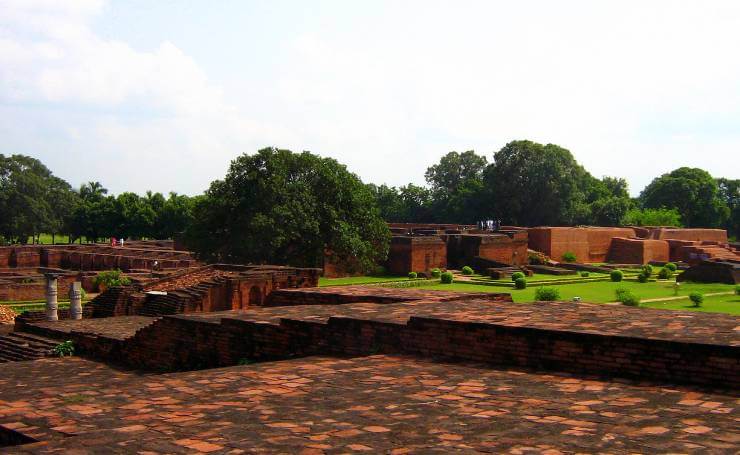
Don’t forget to see India’s first international university of ancient Magadha Kingdom – Nalanda University in Bihar. It used to be located 95 km southwest from the city of Patna. It is one of the top heritage tourist destinations of Incredible India. Why is it important to visit here? The reason is simple. It was the symbol of art and learning in ancient times (5th century CE to 1200 CE). Today it is a UNESCO World heritage site. Nalanda University is considered as a very prominent centre of Vedic learning and Mahayana Buddhism which flourished under the patronage of Gupta empire and later Harsha who was the king of kannauj. Students from outside of India like China, Korea, Mongolia, Tibet etc used to study here. The admission procedure was very difficult. Students had to go through difficult tests by the teacher.
Bakthiyar Khilji a Turkic Muslim invader in 1193 attacked this university and later it was also said to have burned by Mughals. Even after so much devastation, Nalanda University’s ruins still stand in pride carrying the legacy of being the first ever international university of India.
General Information
- Timings- 9:00am to 5:00pm
- Duration- 3 hours
- Entry Fee- ₹ 15 for Indians and SAARC and BIMSTEC citizens; ₹ 200 for foreigners; No entry fee for the children below 15 years of age
Other Interesting Blog to Read
Champaner Pavagadh Archaeological Park, Gujarat
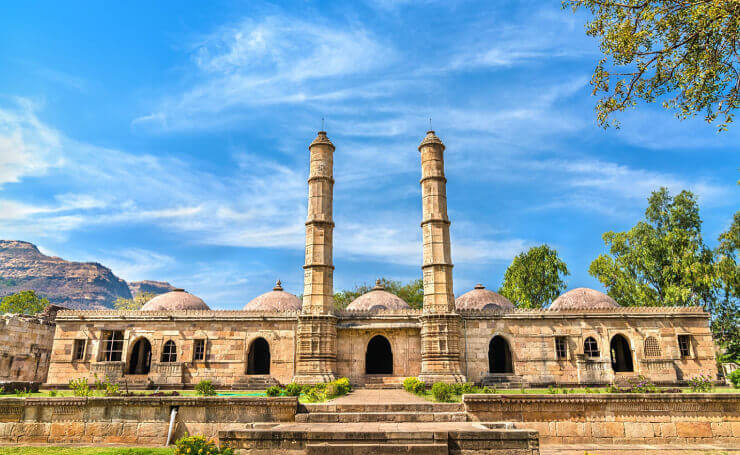
Champaner Pavagadh archaeological Park is one of the best heritage tourism destinations to explore in India. Don’t confuse it with a park for leisure stroll or nature sightseeing, it is actually a cluster of ancient cities from prehistoric to mediaeval period. It is the only unchanged Islamic Pre Mughal-city in India. Park houses ancient hill fortress, ancient religious shrines, chalcolithic sites of prehistoric, palaces, ancient agriculture structures and water installations etc which dates back 8th to 16th century.
One of the major highlights of this park is the shrine of Kalika Mata Temple in Pavagadh hilltop. Devotees from all across India come here to take divine blessings every year.
One of the most amazing facts is that most of the parts of this place are still unexcavated and waiting for attention. Who knows? What else we get to see in future. It also houses Jama Masjid whose extraordinary architecture style became a base model for other architectural marvels in India. You will also witness the ancient village of Champaner here. It is one of the best heritage destinations to explore in your India Trip.
General Information
- Location- Panchmahal
- Duration- 4 hours
- Timings- 8:00am to 6:00pm
Other Interesting Blogs to Read
Gagron Fort, Rajasthan
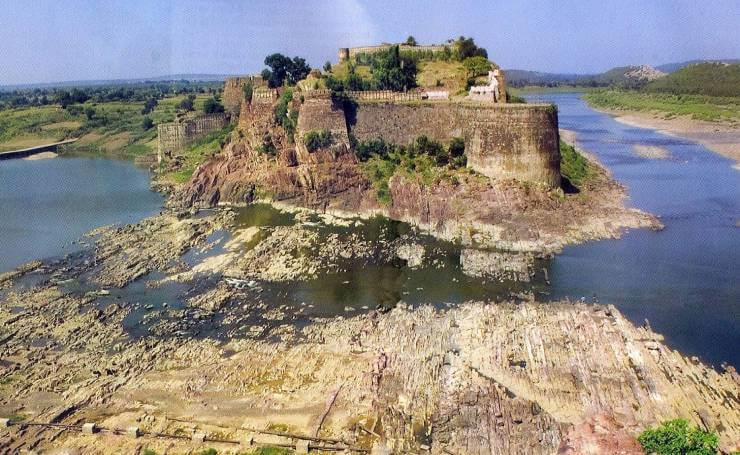
The interesting stories and the beauty of Gagron Fort will enchant your soul. Gagron Fort is a must visit heritage tourism destination to explore in India. Located in Jhalawar district of Rajasthan, it is a beautiful heritage destination in India. It is also a UNESCO World Heritage site due to its unique location and architecture. Surrounded by water on three sides and moat on its fourth side it offers breath-taking views to the tourists. Khinchi rulers ruled over this Fort for 300 years. We also do not know the exact date of its construction but according to historians the fort was built between 7th to 14th century.
The most interesting fact about this fort is that it has Vindhya Mountain ranges as its foundation except that there is no foundation for the fort. It is also surrounded by beautiful Mukundara hills which makes it a gorgeous place for photography.
Some of the popular attractions in this fort are Diwan-I khas, Diwan- I Aam, Rang Mahal, Madhusudan Mandir and Janaana Mahal etc. You will also see a unique species of parrot called Hiraman Parrot which is twice the size of a normal peacock here.
General Information
- Location- Near Kali Sindh River, Jhalawar Rajasthan
- Duration- 4 hours
- Timings- 9:00am to 6:30 pm
Other Interesting Blogs to Read
Ranthambore Fort, Rajasthan
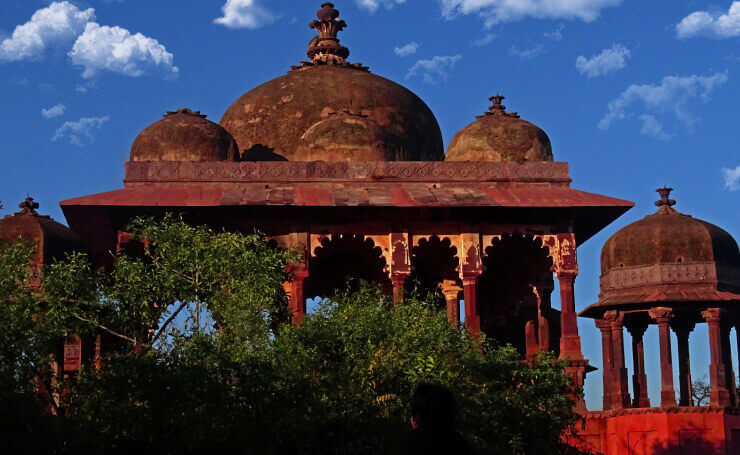
Located near Sawai Madhopur, the magnificent fort of Ranthambore lies within Ranthambore National Park. It is a popular heritage destination to explore in India, decked in the pristine wilderness of Ranthambore Forest. It is also a UNESCO World Heritage site under the category of Hill Forts of Rajasthan. It was built by Chauhan Rajputs in 10th century AD.
It is very popular for the jauhar performance of a royal lady when a Muslim invader Alauddin Khilji laid siege in Ranthambore Fort in 1303 AD. The monuments in the fort also show the secular outlook of its ruler. You will see a mosque as well as temples in this fort. Some of the most attractive attractions are Toran Dwar, Mahadeo Chhatri, Sametonki Haveli and Ganesh Temple. Every year the fair Bhadrapad Sudi Chhaturthi at Ganesh Temple makes this place more soul pleasing.
Mughal emperor Akbar took control of this magnificent Fort and kept it under his region till 18th century but Raja Sawai Madho singh requested Mughals to hand over this fort to him which Mughals accepted. Later Sawai Singh developed a village near this fort and named it Sawai Madhopur.
General Information
- Location- Ranthambore National Park
- Duration- 2 hours
- Timings- You can visit the fort in Wildlife Safaris of Ranthambore Park. 7:00 am to 10:30(morning shift) and 2:00pm to 6:30 pm (evening shift)
Other Interesting Blog to Read
Western Ghats Kerala
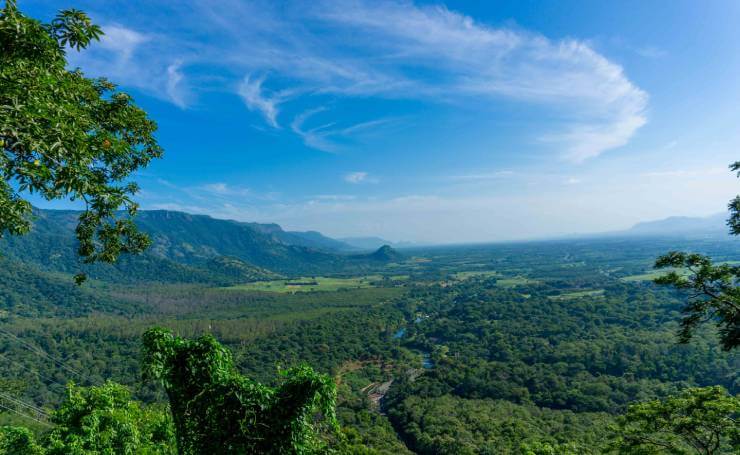
Western Ghats of Kerala is a wonderful nature paradise and one of the most popular heritage tourism destinations to explore in India.
One of the eight biological diversity places in the world and covering over 1600 km in 6 states which are Gujarat, Maharashtra, Goa, Karnataka, Kerala and Tamil Nadu, you will be mesmerised by the beauty of nature. Do you know what we call the forests of western Ghats? No? They are considered as the water towers of India, it houses 58 rivers including Krishna, Kaveri and Godavari. There is no dearth of tourist places to explore in western Ghats. From monuments, biodiversity hotspots, awesome wildlife sanctuaries, lofty mountains, waterfalls, serene temples, hill stations, gorgeous plantation towns etc, you will never be able to forget this trip.
Some of the most enchanting places that come under western Ghats which you can explore for the best India Holiday tour are Agumbe, Dandeli, Madikeri, Chikmagalur, Matheran, Ooty, Mahabaleshwar, kudremukh etc. The list is endless. Visiting Western Ghats will be one of the most delightful experiences of Indian Heritage Tourism. It was declared as a UNESCO World Heritage site in 2012.
General Information
- Best Time to Visit- October to June
- Best Places – Agumbe, Dandeli, Madikeri, Chikmagalur,Matheran, ooty, Mahabaleshwar, kudremukh etc.
Other Interesting Blogs to Read
Kakatiya Rudreshwara Ramappa Temple, Telangana
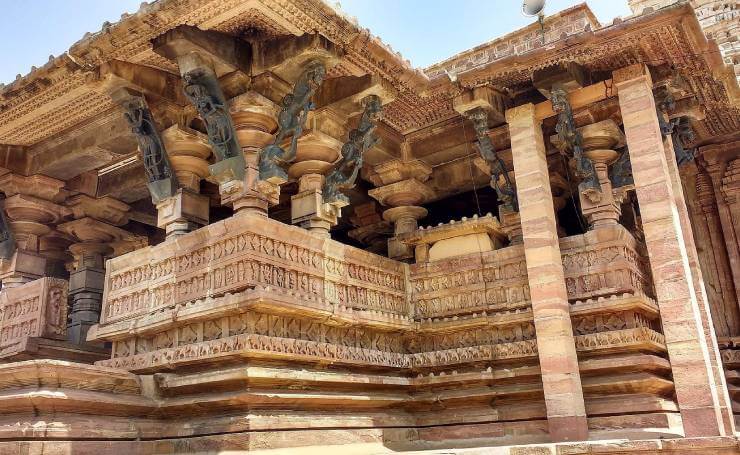
Rudreshwara also known as Ramappa Temple is located in the village of Palampet. It is one of the most popular heritage destinations to visit in India. It was declared as a UNESCO World Heritage Site in the year 2021. The temple was built during the Kakatiya Period (1123-1323CE) by the rulers Rudradeva and Rachala Rudra.
It took 40 years to build this magnificent temple which is also the reason why it is so beautiful. The sculptures you will see here are an epitome of beauty. It depicts the regional dance customs and Kakatiyan culture. Moreover, it is placed in a natural setting with a strict adherence to dharmic texts. According to Dharmic texts a temple should be built in a natural setting where there are hills, beautiful lakes and streams, forests, mountains, agricultural fields and catchment areas etc.
The Carved granite pillars and roof structures of this temple is made up of floating bricks, it is also one of the most gorgeous sights to behold. One must visit this amazing Heritage destination in India.
General Information
- Location- 70 Km from Warangal by road
- Duration- 2-3 hours
- Timings- 6:00am to 6:00pm
Other Interesting Blog to Read
Madavoorpara Rock Cut Temple, Kerala
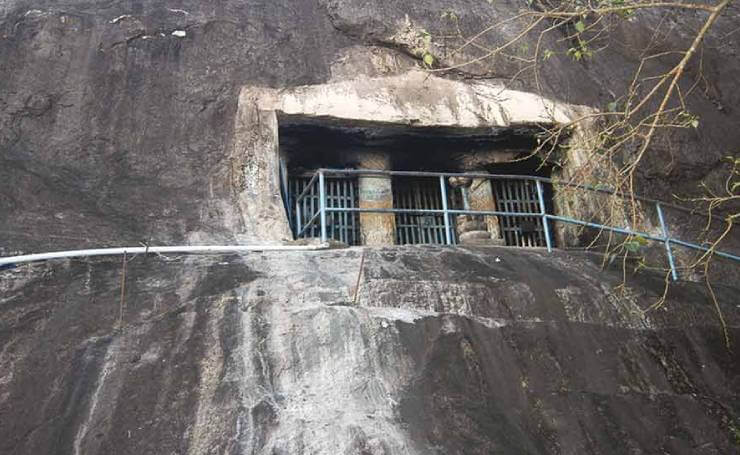
Dedicated to lord Shiva, Madavoorpara Rock Cut temple is a beautiful heritage destination in India. It is located in Chenkottukonam in Thiruvananthapuram. This temple was built in the 8th century CE by a Buddhist monk. Earlier this temple was owned by Chenkottukonam ashram but later the archaeological department of the state took its charge in 1965.
There is a bamboo bridge near the temple which is a wonderful relaxing spot to spend delightful time with family and friends. There is also a sacred pond known as Ganga Teertham in a rugged hill which is one of the must visit tourist attractions near this temple. The lush greenery all around will refresh your mind, body and soul. The ambiance of this amazing spiritual spot makes this place best for a relaxing heritage tour in India.
General Information
- Location- Chenkottukonam
- Timings- 6:30am to 7:00pm
- Duration- 2-3 hours
Other Interesting Blog to Read
Akhnoor Fort, Jammu and Kashmir
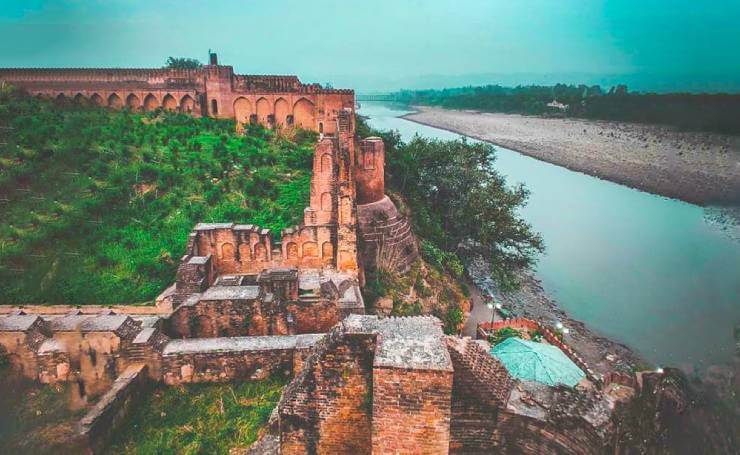
Akhnoor Fort, located a few kilometres away from Jammu, is the pride of Jammu, it attracts locals as well as tourists. Situated on the blissful banks of the Chenab River, it is one of the most popular heritage destinations to explore in India. This huge fort is a masterpiece of Indian military architecture. It got the honour of a National Monument under the Monuments Act 1958 and is protected by the Archaeological Survey of India due to its great historical and cultural importance. You can reach here through the river or the northern entrance. Breath taking views of Shivalik range and Trikoot mountain and the Chenab River flowing down makes the surroundings of Akhnoor fort enchanting.
Akhnoor Fort was built by Raja Alam Singh in 1802. The construction of the fort started in 1762 on the request of Raja Tegh Singh and was completed in 1802 by his son Raja Alam Singh. The excavation of the fort is still in progress, and it is divided into three periods. The red and grey pottery of the Harappan civilization, such as pots, dung and beakers, is characteristic of the first period. Historical pottery is associated with the second century, while Kushan artefacts are associated with the third.
General Information
- Location-Right banks of Chenab River
- Duration – 3 Hours Minimum
- Timings- 10:00am to 6:00pm
Also Read: Heritage Tourism in Jammu and Kashmir
Khetri Mahal, Rajasthan
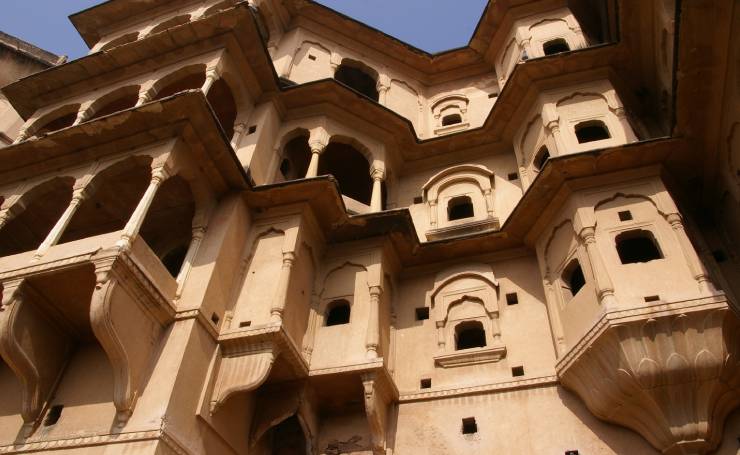
In the Western End of Nehru Bazaar in Jhunjhunu District, the magnificent Khetri Mahal has been captivating the minds of tourists for ages. It is one of the less explored heritage tourism destinations in India which you must visit for a wonderful India heritage Tour.
It was built by Bhopal Singh in the year 1770. The most interesting fact about this place is that there are no windows and doors in this Mahal but it is known as Wind Palace. Its unique architecture allows the stream of Uninterrupted winds to pass from here. The rooms are connected through pillars and arches which makes it quite an attractive sight to behold. It is an excellent masterpiece of Shekhawati art and architecture which you must explore in India.
General Information
- Location- Bada Mohalla, Jhunjhunu Rajasthan
- Duration- 2-3 hours
- Timings- 10:00am to 5:00pm
We hope that after reading this blog you will be able to plan a wonderful heritage tour to India. Visiting these Heritage attractions will take you to the soul of Incredible India. Do share your memorable heritage tour journey in the comment section of the blog.
Other Interesting Blogs to Read
Like & Follow our social media accounts at Twitter, Facebook, Linkedin & Instagram for getting the latest updates & offers on holiday packages.
Disclaimer: We do not take credit for some of the licenced paid images used in our blogs, whether from Google Images, Fotolia & Shutterstock. All such images are the copyrights of their respective owners and we try to provide credit for them wherever we can. If, however, any copyright image has been used on our blog, the concerned person can either mail us directly to remove the image or provide credit to whomsoever the image may belong to.
Frequently Asked Questions
What are the best must visit heritage tourist places in India?
For an Incredible heritage tour you can visit all the UNESCO Heritage which will give you wonderful travel experience and a vast knowledge about India’s heritage and culture –
- Agra Fort
- Taj Mahal
- Hill Forts of Rajasthan
- Western Ghats
- Kaziranga National Park
- Pattadakal Group of Temples
- Khajuraho Group of Temples
- Hampi Group of Temples
- Sanchi Stupa
- Humayun’s Tomb
- Qutub Minar
- Mountain Railway of India
- Ahmedabad
- Red Fort
- Jama Masjid
- Jantar Mantar Rajasthan
What makes Delhi a must visit places to experience Indian Culture?
Culture of Delhi is best reflected in its food which has multi culture influence. You will find here the delicacies from every corner of India. Heritage monuments of Delhi are one of a kind. You will see a beautiful blend of tradition and modernity. Old Delhi will take you to the legacy of Mughals, Delhi Sultanate etc and New Delhi will give you colonial vibes. It also has amazing shopping places where you can see the delightful chaos of people. You will see a good collection of India Art Craft, woven silk, handicrafts, home decors and many more things. The delightful city chaos and food, cultures and heritage sites make it a must visit place to visit in India.
How many types of heritage tourism to experience in India?
There are three main types of Heritage tourism
- Cultural Heritage Tourism - Places of Cultural significance like religious spots, villages, experiencing festivities etc
- Natural Heritage Tourism - Includes all the places of nature
- Mixed Heritage Tourism - It has elements of Both natural as well as culture
Which are the top 10 most visited heritage attractions in India?
The top 10 most visited heritage attractions in India are-
- Taj Mahal
- Hill Forts of Rajasthan
- Western Ghats
- Kaziranga National Park
- Pattadakal Group of Temples
- Khajuraho Group of Temples
- Hampi Group of Temples
- Sanchi Stupa
- Humayun’s Tomb
- Qutub Minar
About the author
From the Lake District, Nainital, Nidhi Singh is a travel writer whose love for mountains can be seen in her write ups. Talk about solo travelling, indulging in adventure activities, binging on good food, planning budget trips or the Aurora Borealis and you will get all her attention. It is the wanderlust that keeps her going and if at all she could get one wish granted she would love to live a life less ordinary. Follow her on Twitter, Facebook & Instagram.

 +91-9212777225
+91-9212777225 Plan Your trip
Plan Your trip